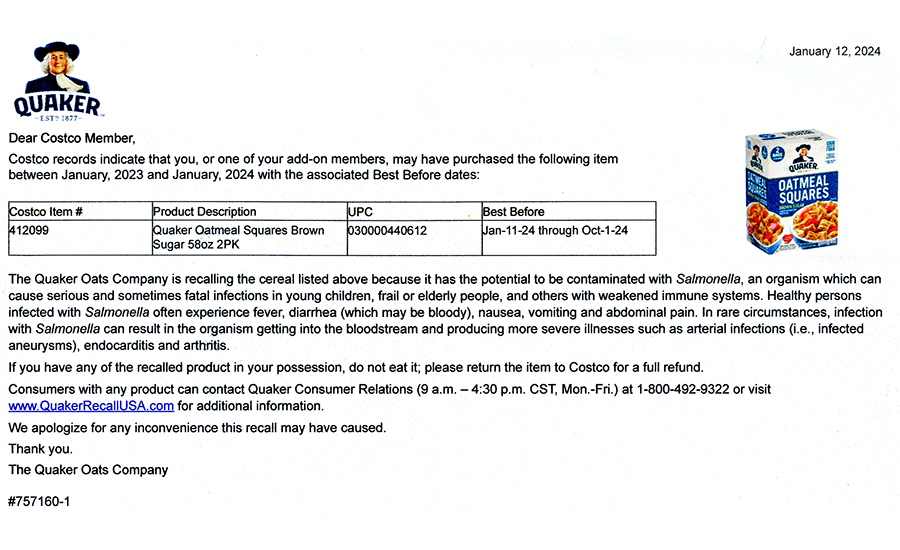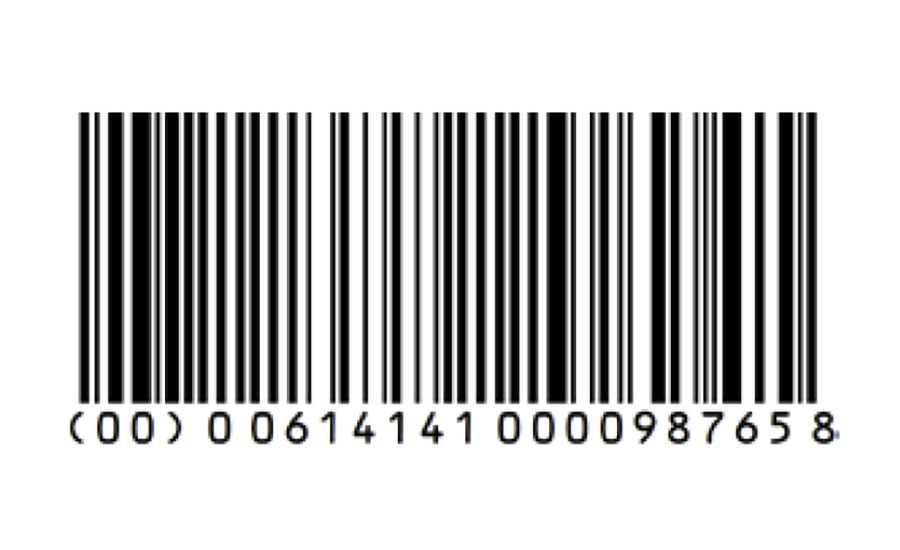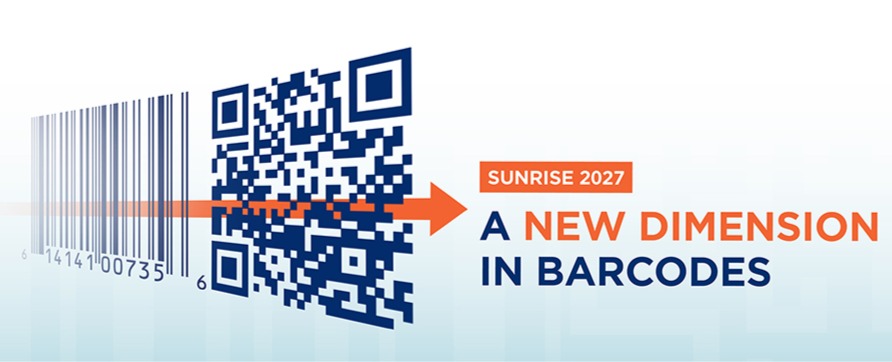Track and Trace Gets a Boost from GS1 12 and 128 Barcodes
The humble barcode on a food product is both a track-and-trace and a marketing tool.

Courtesy of Getty Images / NatFilm
Those barcodes (aka, Universal Product Code or UPC) you see on your cereal package don’t get much notoriety. They’re scanned at the grocery or the big-box store on checkout, and that’s pretty much the end of it for the customer—unless a product is recalled. The sales data goes back through the supply chain to the food processor and provides valuable marketing and supply chain data. More than that, however, should a recall occur, the data contained in that UPC label is a key starting point for a recall. That 12-digit UPC can be associated with other product data or a GS1-128 barcode (typically appears in the supply chain but isn’t public), which can contain vital supply chain data as well as far more product info than contained in the 12-digit code.
As a consumer having had a breakfast cereal recently recalled, I realize the importance of the 12-digit UPC/barcode, which appeared on the FDA recall and on a large postcard that I received from Costco, where I had purchased the cereal. Kudos to Costco also for providing an automated phone call (including UPC) about the recall the very next day after it had appeared on the FDA website.

To gain a better understanding of how barcodes work in a track-and-trace situation, I went to the source and spoke with Liz Sertl, senior director, supply chain visibility for GS1 US. GS1 is the not-for-profit standards organization and primary source for all those barcodes we take for granted.

Sertl has more than 20 years of experience in the CPG industry. Working closely with supply chain partners, she facilitates collaboration best practices and guidelines that help companies improve product traceability and supply chain visibility through the adoption of GS1 Standards.
FE: Liz, tell me a little about the history of GS1 and UPC. How did GS1 and GS1 US come to be?
Liz Sertl: The first barcode scan—ever—took place almost 50 years ago. That’s where the story of GS1 Standards and GS1 US began. The grocery industry came together in the 1970s to speed up the checkout process and drive efficiency. Industry agreed on the UPC barcode as a way to do just that. Cooperation within industry marked the birth of GS1 US and the mission to help organizations of all sizes uniquely and consistently identify products, assets and physical locations throughout the global supply chain while also enabling trading partners to exchange information critical to their businesses. We like to think of GS1 Standards as the “global language of business.”

FE: What is a GS1 UPC-A barcode? What does it contain in terms of information/data?
Sertl: A UPC-A barcode (or UPC) barcode is linear in design and is one-dimensional. It’s probably the barcode structure that looks the most familiar. The UPC is a global standard and is one of many used in trade. Typically, you’ll find a UPC on retail products, like a gallon of milk, loaf of bread, soft drink bottle, bag of chips…it’s what enables the scanner at the checkout to go beep.
Encoded within that UPC is a unique sequence of 12 digits that help identify the specific product and the manufacturer. Those 12 digits make up the Global Trade Item Number (GTIN). It’s a globally unique number that is used to identify your specific product.
People do use GTIN and UPC as interchangeable terms, but there is a key distinction. In the GS1 system, there are data carriers and the data itself. The data carrier is the actual machine-readable barcode (aka, the lines and spaces) that contains important data, like the GTIN. The GTIN 12 is the form of GTIN that is predominately used in North America and is intended to be scanned at the point of sale (POS).

FE: What is a GS1-128 barcode, and what does it contain? Is there an advantage to using this for track and trace/logistics/inventory systems over the UPC-A code? Is the GS1-128 code more expensive than the UPC-A code?
Sertl: First and foremost, the GS1-128 barcode contains more information than a UPC and is not more expensive than something like a UPC.
GS1-128 barcodes are often applied on higher levels of packaging beyond the item level to give more specificity to the barcode. These are not meant to pass through point of sale because traditional laser scanners cannot read the additional information that this barcode can hold.
GS1-128 barcodes can carry all of the GS1 identification keys beyond just the GTIN. GS1-128 barcodes can also encode detailed product information such as batch/lot, serial number or expiration date, which is why they are so beneficial in shipping, receiving and warehouse scanning environments. If you do encode multiple pieces of information in a GS1-128, a single scan of the barcode is all it takes for your supply chain partners (e.g., shipper, distributor, fulfillment center) to capture detailed information that not only supports supply chain efficiency, but also is a key part of product traceability, helping sellers become better prepared for recalls, too.
Working harmoniously, all of these elements help identify your products as they travel throughout the supply chain.
FE: As far as I know as a self-publisher, Bowker is the only direct source for ISBNs—the barcodes appearing on books. Is GS1 the only source for UPC and GS1-128 barcodes? Are there brokers that can resell numbers? How do I know what are legitimate sources of GS1 codes?
Sertl: There are third parties that sell barcodes, and there are lots of risks associated with those—including corresponding to other products and not scanning at POS. Issues like that can result in lost sales, damage a brand’s reputation and more. If businesses are looking to sell in brick and mortar, e-commerce or even start at the farmer’s market and work their way up to selling in retail, it’s best to start off on the right foot and license a barcode/identifier from GS1; it is the trusted name in barcodes/identifiers.
GS1 has a resource available to check and see which identifiers are licensed to which brand owners. The tool is called Verified by GS1 Search. Since trusted and accurate data is so crucial to efficiency and supply chain visibility, this tool empowers anyone to lookup the information behind the barcode. Visit and query our global registry of GS1 identification numbers. You can search by product, verify company information, look up location/party details and validate data against a global and trusted platform.
FE: What is a company prefix? Is this a must for a small food manufacturer just starting out? What do you suggest for a small company—say beverages—that only intends to have ten flavors? Does the company need different UPC numbers for each size it intends to sell, e.g., 12-oz. bottle, 1-L bottle, 12-oz. can, etc.? Is this where a GS1-128 code makes more sense?
Sertl: A GS1 Company Prefix is a set of unique numbers that identifies a company within product or location identification numbers. To obtain one, companies can approach GS1 US or any GS1 member organization. A prefix can be licensed in different capacities, starting from 10 and going up to 100,000. This allows the company to create different kinds of identifiers like GTINs and GLNs (Global Location Numbers).* Licensing a Company Prefix is the first step toward helping businesses identify their company, their products, their shipments, their locations and their parties.
The GS1 Company Prefix is not necessarily a must for a food manufacturer just starting out, but if that operation is thinking about growth and expanding its product portfolio, the GS1 Company Prefix is definitely worth considering.
There are single GTINs available to license, but most businesses start out using a GS1 Company Prefix to barcode their products. Once those businesses start barcoding, they often find that having the prefix becomes more and more relevant as they grow, especially when they start working with multiple retailers or logistics partners. The GS1 Company Prefix helps power a more cohesive ecosystem among your trading partners, making traceability more efficient.
In thinking about how many identifiers you might need when identifying your products with something like a GTIN, which is encoded in the UPC, think about sellable units. If it’s a different sellable unit, you’ll need a different unique identifier for each sellable unit. If you have a box of pasta—same brand, same weight—and the only difference is one is gluten-free and the other has gluten, each of those products needs a separate GTIN.
In this case, the GS1-128 is not applicable. The GS1-128 barcode would be used to identify the case or carton level—and that barcode can carry any of the GS1 ID keys (e.g., GTIN), plus information like serial numbers, expiration dates and more. You would not identify a sellable unit with a GS1-128.
It’s important to note that brands and retailers are moving toward adoption of new two-dimensional (2D) barcodes (e.g., GS1 DataMatrix) that can be embedded on product packaging with virtually limitless amounts of data compared to the traditional linear UPC barcode. In fact, the retail industry has committed to become capable of implementing and scanning 2D barcodes at point of sale within the next three years in a GS1 US-led initiative called Sunrise 2027.

FE: Can the GS1-128 barcode accommodate batch numbers, units produced, time/date, etc.? In recall situations, the FDA or USDA will specify this data to narrow down the problem batches. How does a food processor manage this extra data? Does GS1 care about this additional data (i.e., is it documented at GS1)? Is there a “master database” somewhere? What about FSMA 204?
Sertl: Since the GS1-128 can hold more data—the GTIN, batch/lot code and key date information such as expiry, best before date, sell by date, production date and packaging date—the GS1-128 is a standard that can power your recall management. Oftentimes when product is recalled, that contaminated food will be tracked and traced by using information in the GS1-128.
If we are talking recall management, having that next level of supply chain visibility is key, and other GS1 Standards can help a business get there too. It’s important to keep in mind, especially as FSMA 204 is around the corner.
The U.S. Food and Drug Administration recently announced its Final Rule detailing requirements for capturing additional traceability records for certain high-risk foods to satisfy Section 204 of its Food Safety Modernization Act (FSMA). It mandates increased data collection and recordkeeping for companies providing high-risk foods such as deli meats, salads, cheeses, fresh produce and eggs, among others. To meet the new rule’s January 20, 2026, compliance deadline, organizations must prepare their data capture and record keeping processes within the next three years. It is crucial for businesses handling foods on the FDA’s Food Traceability List (FTL) to start preparing now.
The primary objective of the new rule is to reduce foodborne illness outbreaks by enabling swift identification and removal of contaminated products from the supply chain. It specifically focuses on food categories that are frequently associated with outbreaks in the U.S.
GS1 Standards can play a vital role in removal of that contaminated food since they encompass product and location identification, automated data exchange and transactional data sharing.
FE: I can’t imagine any food company—other than maybe a local farm store selling its own products—that would not use a barcode. What are the advantages of using the barcodes from a marketing perspective?
Sertl: Having a GS1-sourced barcode/GTIN secures a business’s place in global commerce. Any brand selling a product around the world—from large multinationals to small businesses—should ideally have GTINs to identify products as they move through the supply chain.
Credibility is key in marketing, especially when communicating about food. A GTIN is just that—it’s a symbol of credibility. It establishes the product and signifies it is ready to be accepted by retailers and consumers. It opens the door to opportunities to sell in multiple places and can help a small business grow. GTINs are backed by a 50-year-old, trusted system based on industry collaboration. You don’t want just any barcode to be attached to your product—and not all barcodes are created equal.
Barcodes and having your products properly and uniquely identified can also move the needle in searchability. According to Google, products that include GTINs have a 40% higher click-through rate when searching online.
FE: Are GS1 barcodes required for exporting food/beverage products to other countries? Canada, Mexico, Europe? What is required in terms of coding for exports?
Sertl: GS1 Standards (which include barcodes) are the most widely used supply chain standards in the world, and they are completely voluntary. It’s 100% a best practice to use GS1 Standards to identify your products, especially since most retailers require them to be able to sell on their marketplaces.
FE: What else is important to know especially about GS1 barcodes and track and trace?
Sertl: GS1 Standards are the foundation to tracking and tracing goods in the supply chain. All the way upstream and down to the recycling process—GS1 Standards can deliver that next level of supply chain visibility.
Think about traceability through the eyes of the consumer. Their needs are changing. They want to know more about where food comes from, what’s in their products and how safe it is. GS1 Standards play an important role in the identification of products and locations, which contribute to accurate tracking and tracing in the supply chain. Those GS1 Standards can help consumers understand a product’s journey from “farm to fork,” and support programs that substantiate sustainability claims such as non-GMO and organic. And from a B2B perspective, GS1 Standards help companies meet the requirements of FDA regulations such as FSMA 204.
(*Editor’s note: GLNs identify physical locations, legal entities and operations centers and are often used for the purpose of EDI (electronic data interchange) communications.)
Looking for a reprint of this article?
From high-res PDFs to custom plaques, order your copy today!







